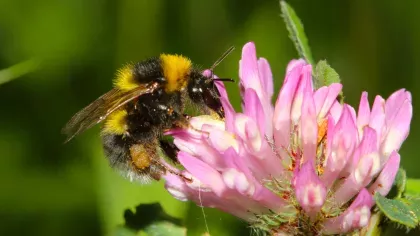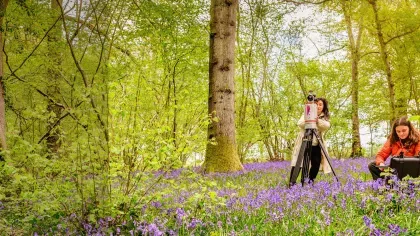5 September 2023
Finding the best trees for bees
From tree traps to nature apps, find out how we're researching the benefits of biodiversity for bees this summer.

There are over 20,000 different species of bee around the world, and 270 in the UK alone. But wild bee populations are in decline.
As we lose more and more biodiverse habitats, resources such as pollen and nectar for bees dwindle.
Through our Nature Unlocked research, we’re working to understand the trees and plants that encourage the highest abundance of pollinators in our changing climate. With this information, we’ll be able to inform urban landscape planning and bring the buzz back to our environments.

Looking up
Whilst there have been many studies over the years focusing on pollinators, very few have looked at the value of trees within pollinator communities.
With a new pollination research team in place, we’re using Wakehurst’s diverse habitats as a living laboratory to understand which trees and plants are providing the most benefits for pollinators.
Over the summer, the team set out traps both within trees and across grasslands to see which plants, trees and habitats attract different invertebrates.
Where possible, they’ll take pollen samples to see where else the pollinators have been exploring. The insects are then taken back to the Millennium Seed Bank laboratories, where the team can take a closer look and identify the species.
Elsewhere, transect walks and regular insect identification are helping to build the full picture of Wakehurst’s pollinator population.


With solitary bees checking into hotels across the gardens, pollen samples from their larvae nests can easily be taken without disturbing residents.
Only a small amount is needed to understand where the bees have been, and in particular which trees they’ve taken a fancy to.

Engaging Citizen Scientists
For the next stage of Trees for bees, we’re turning to you.
In order to fully understand what our pollinators are foraging at Wakehurst, we need your help!
We would like our citizen scientists to walk around the gardens, counting the insects that are visiting flowering or pollen-producing trees to help us collect critical data essential for our scientist's work.
You don’t need to be an expert, as long as you love walking at Wakehurst and are interested in being part of a major research project.
Just download the Trees for Bees app, pick up a Trees for Bees guide on your next visit and get monitoring.


Pollinator paradise
Although we’ve selected individual trees for our Trees for Bees study, our pollinators can be found all over.
Open woodlands and flower-rich meadows provide the perfect spot for pollinators.
Areas such as Coronation Meadow and Bloomers Valley offer a sensory treat, for both insects and humans alike! Take in sweeping vistas, listen out for the symphony of insect sounds and see what you can spot buzzing around our native wildflowers.
Its grassland cousin, the American Prairie, also provides pollinators with an appetising spread of non-native species – the subject of a Nature Unlocked study last year.
As many non-native species flower later than native meadows, these are especially important for UK pollinators, extending the nectar resources beyond a typical season.

These are a few of our favourite bees
Although bees may get a bad reputation in Maria’s The Sounds of Music number, we think our pollinator pals are pretty impressive.
With so many species buzzing around the UK, including 24 bumblebees, we asked our experts which are their favourites and why.
Research Lead, Phil Stevenson shared, ‘My favourite bee is the Sainfoin bee (Melitta dimidiata). This is one of the UK's rarest bees with records confined to a few sites in the Salisbury Plain area.
It is restricted to feeding on Sainfoin (Onobrychis viciifolia), which is especially exciting for us at Kew as it is one of the plants where we have discovered natural plant compounds in the nectar with medicinal properties for bees.
The Sainfoin bee is also a great example of a monotectic bee - a specialist bee that only feeds from just one species of plant. This illustrates how fragile some populations of bees are and why it is so important to have flower diversity – if we don’t have Sainfoin flowers we don’t have Sainfoin bees.’
Katie Berry, Research Assistant: ‘My favourite is the Early bumblebee, (Bombus pratorum). As the name suggests, these are often one of the first bumblebees to emerge in early spring. Seeing these colourful little guys reminds me that summer isn't far away!’


Dr Janine Griffiths-Lee, Post-doc Research Associate: ‘My favourite bee is the Ashy Mining Bee, (Andrena cineraria). They are just so beautiful and distinctive, with ash-grey hairs and a glossy blue-black abdomen.
They nest in the ground by excavating small tunnels and close the entrance holes to the burrows when they have finished foraging for the day.’
Rachel Wilkinson, Research Assistant: ‘My favourite bee is Bombus vestalis, the Southern cuckoo bee. It's so interesting how these guys lay their eggs in the nest of buff-tailed bumblebees (Bombus terrestris), similar to cuckoo birds, to avoid rearing their own young.’


As science continues across our gardens, keep an eye out for our scientists, and of course pollinators!



